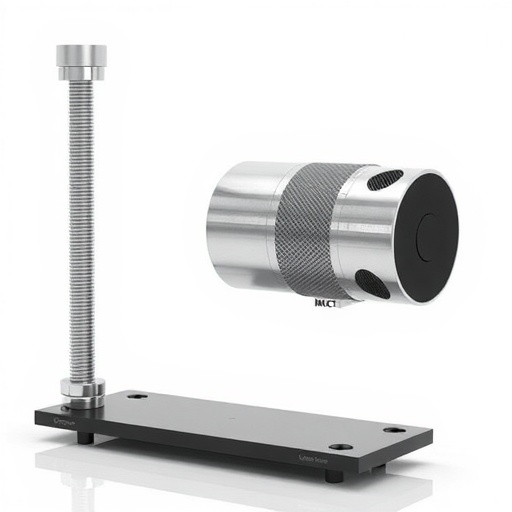In a groundbreaking study, Elong, Kasim, and Badar delve into the enhancement of the structural stability and electrochemical performance of NMC 111 (Nickel Manganese Cobalt) cathodes by employing an innovative doping strategy. Lithium-ion batteries, pivotal in powering an array of modern devices from smartphones to electric vehicles, are in dire need of advancements that not only improve their lifespan but also their performance metrics. The researchers aim to reconcile these needs through the incorporation of aluminum and titanium into the NMC 111 structure, providing an ambitious step forward in battery technology.
Current lithium-ion battery technology hinges heavily on the performance of the cathode material, where NMC 111 is often favored due to its optimal balance of capacity, voltage, and thermal stability. However, the potential degradation of its structure during charge and discharge cycles poses a significant challenge. The study details how aluminum and titanium doping can mitigate structural instability, thus prolonging battery life and ensuring consistent performance. This is particularly crucial as the demand for more robust and reliable energy storage solutions continues to grow amidst the electrification trend.
In their research methodology, the authors achieved doping through a meticulous process where aluminum and titanium ions were introduced into the NMC 111 lattice. This intentional structural modification is significant as it alters the electrochemical pathways and mechanical properties of the electrode material. Scientific literature indicates that optimized composition in cathodes can significantly improve capacity retention and cycling stability, which the authors substantiate through rigorous experimental validation.
The authors also explore the microscopic changes that occur due to doping. By utilizing advanced characterization techniques such as scanning electron microscopy (SEM) and transmission electron microscopy (TEM), they provide compelling evidence of morphology changes post-doping. Notably, the microstructure exhibited enhanced crystal stability and reduced phase transitions, which are critical factors contributing to the overall electrochemical performance of lithium-ion batteries.
Moreover, the research emphasizes utilizing various electrochemical testing methods to evaluate performance impacts. Through cyclic voltammetry (CV) and electrochemical impedance spectroscopy (EIS), the authors were able to systematically assess the influence of aluminum and titanium on key performance indicators such as charge-discharge efficiency, lithium-ion diffusion coefficients, and overall energy density. The accompanying results revealed marked improvements across these metrics, suggesting a strong correlation between doping levels and enhanced performance.
In terms of real-world applicability, this study holds promise for the manufacturing of next-generation battery technologies that not only meet consumer demands but also advance the environmental narrative by promoting longer-lasting batteries and reduced waste generation. The industry’s move towards sustainable energy solutions hinges on the development of materials that can endure the rigors of daily use while minimizing depletion of resources.
A relentless focus on sustainability provides context for the necessity of this research. With a global shift toward greener energy solutions, optimizing battery performance is critical for the enhancement of renewable energy systems. The extended lifespan and reliability of lithium-ion batteries through doping techniques could significantly reduce the carbon footprint associated with battery production and disposal.
Additionally, as electric vehicles gain momentum, the need for improved battery technology becomes increasingly urgent. Doped NMC 111 materials may facilitate faster charging times and greater distance per charge—two attributes that are essential for consumer acceptance of electric vehicles. The capacity to improve range and efficiency directly correlates with consumer confidence, making this avenue of research vital to the automotive industry’s future.
The impact of this research is anticipated to ripple through various sectors, influencing not only consumer electronics but also larger-scale applications in grid energy storage. The dual challenge of intermittency and duration of renewable energy sources like solar and wind can be addressed effectively with robust energy storage systems anchored by advanced battery technology.
Academic institutions and industry stakeholders alike have begun recognizing the significance of structural integrity in battery materials. This research paves the way for collaborative efforts towards developing new standards and benchmarks that could redefine energy storage in technology. Collaboration across disciplines, pooling knowledge from materials science to engineering, is paramount to realizing the potential of these findings in commercial applications.
Further studies suggested by the authors will focus on optimizing the doping concentrations to achieve a balance between performance gains and material costs. Such efforts will ensure that these advancements do not just remain theoretical but transition into practical, market-ready solutions. Hence, while this initial study illuminates a promising pathway, it simultaneously sets the stage for a broader quest for refined applications of doped materials in real-world settings.
In conclusion, the research conducted by Elong, Kasim, and Badar marks a tantalizing progression in the field of lithium-ion batteries. By marrying structural innovation with strategic doping techniques, the potential to revolutionize energy storage solutions becomes clearer. As researchers continue to explore these cutting-edge advancements, the vision of a sustainable, battery-powered future inches ever closer to reality, igniting excitement within both the scientific community and the consumer market.
Subject of Research: Enhancement of structural stability and electrochemical performance of NMC 111 for Lithium-ion batteries through aluminum and titanium doping.
Article Title: Aluminum and titanium doping: a strategy for enhancing the structure stability and electrochemical performance of NMC 111 for Li-ion batteries.
Article References: Elong, K., Kasim, M.F., Badar, N. et al. Aluminum and titanium doping: a strategy for enhancing the structure stability and electrochemical performance of NMC 111 for Li-ion batteries. Ionics (2025). https://doi.org/10.1007/s11581-025-06576-8
Image Credits: AI Generated
DOI: https://doi.org/10.1007/s11581-025-06576-8
Keywords: Lithium-ion batteries, NMC 111, structural stability, electrochemical performance, aluminum doping, titanium doping.




